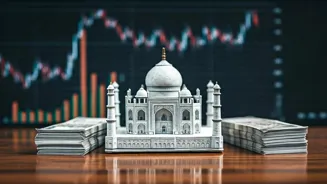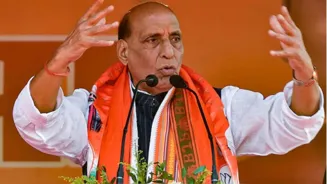What is the story about?
S&P Global Ratings on Thursday upgraded India's long-term unsolicited sovereign credit ratings to 'BBB' from 'BBB-', citing buoyant economic growth, fiscal consolidation, and efforts to improve spending quality.
The agency said that India's outlook on the long-term rating is stable and revised short-term ratings to 'A-2' from 'A-3'.
It further revised India's transfer and convertibility assessment to 'A-' from 'BBB+'.
In practical terms, the S&P' Global's revisions mean that India is now seen as a more reliable borrower and investors confidence in the country's long-term economic outlook has improved. The country may also secure international loans at lower rates.
The S&P Global said, "The stable outlook
reflects our view that continued policy stability and high infrastructure investment will support India's long-term growth prospects. That along with cautious fiscal and monetary policy that moderates the government's elevated debt and interest burden will underpin the rating over the next 24 months."
The S&P Global said that the Indian economy remains "resilient" with "broad-based growth".
The S&P Global forecast India's real GDP growth at
6.5 per cent this year, which compares favourably with emerging market peers amid a broad global slowdown.
"Public investment and consumer momentum will underpin solid growth prospects over the next three to four years. We expect policy continuity post-elections, which would support further economic reforms and fiscal consolidation," the agency further said.
In the coming years, India would average at 6.8 per cent economic growth over the next three years, the agency said.
'Effect of US tariffs
Even though the United States is India's largest trading partner, the agency said that 50 per cent will not drag down India's economic growth.
Trump has slapped 50 per cent tariffs on India. He first imposed 25 per cent tariffs on July 31 and then topped it with 25 per cent on August 6 over the purchase of Russian oil.
Factoring in sectoral exemptions on pharmaceuticals and consumer electronics, the exposure of Indian exports subjected to Trump's tariffs is lower at 1.2 per cent of GDP and while this may
eventually result in a one-off hit to growth, the overall impact should be marginal and will not derail India's long-term growth prospects, the agency said.
India may also not find it hard to switch away from Russian oil, the agency said.
"We expect that in the event India has to switch from importing Russian crude oil, the fiscal cost, if fully borne by the government, will be modest given the narrow price differential between Russian crude and current international benchmarks," the agency said.
The agency said that India's outlook on the long-term rating is stable and revised short-term ratings to 'A-2' from 'A-3'.
It further revised India's transfer and convertibility assessment to 'A-' from 'BBB+'.
In practical terms, the S&P' Global's revisions mean that India is now seen as a more reliable borrower and investors confidence in the country's long-term economic outlook has improved. The country may also secure international loans at lower rates.
The S&P Global said, "The stable outlook
'Resilient economy with broad-based growth': S&P Global on India
The S&P Global said that the Indian economy remains "resilient" with "broad-based growth".
The S&P Global forecast India's real GDP growth at
"Public investment and consumer momentum will underpin solid growth prospects over the next three to four years. We expect policy continuity post-elections, which would support further economic reforms and fiscal consolidation," the agency further said.
In the coming years, India would average at 6.8 per cent economic growth over the next three years, the agency said.
'Effect of US tariffs
will be manageable'
Even though the United States is India's largest trading partner, the agency said that 50 per cent will not drag down India's economic growth.
Trump has slapped 50 per cent tariffs on India. He first imposed 25 per cent tariffs on July 31 and then topped it with 25 per cent on August 6 over the purchase of Russian oil.
Factoring in sectoral exemptions on pharmaceuticals and consumer electronics, the exposure of Indian exports subjected to Trump's tariffs is lower at 1.2 per cent of GDP and while this may
India may also not find it hard to switch away from Russian oil, the agency said.
"We expect that in the event India has to switch from importing Russian crude oil, the fiscal cost, if fully borne by the government, will be modest given the narrow price differential between Russian crude and current international benchmarks," the agency said.
Do you find this article useful?















